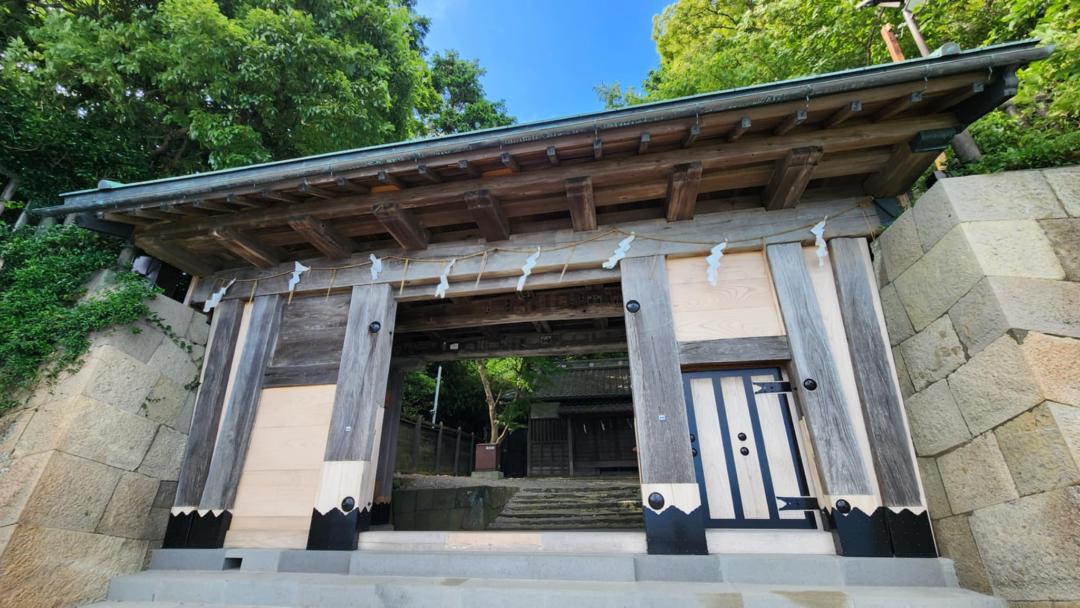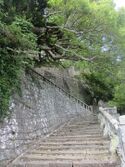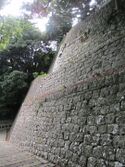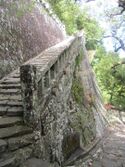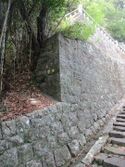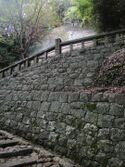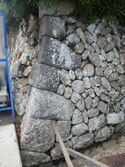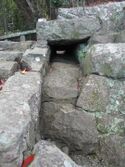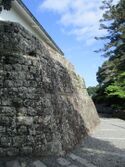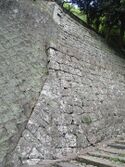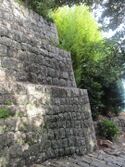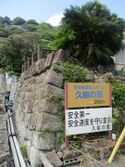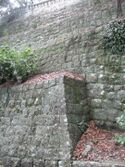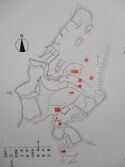Kunou Castle
I visited the former site of Kunōjō, now the Kunō-Tōshōgū shrine, to see the ichinomon (first gate) which is said to be a relic of the castle which used to stand on the mountain. The gate has been extensively restored, but, unlike many gates relocated to temples, it still has the look of a medieval
History
Kunōjō was constructed in the Sengoku period by the Imagawa Clan. When Imagawa Ujiteru died in 1536, the inheritance of clan leadership by Imagawa Yoshimoto was opposed by Genkō Etan who raised an army at Kunōjō to oppose him. Imagawa, supported by the Hōjō, defeated Genkō at Hanakurajō. During the Takeda's invasion of Suruga, Kunōjō, owing to its position on a mountain overlooking the coast, was extensively renovated to serve as a base for maritime surveillance. The Takeda placed the Imafuku Clan in charge of Kunōjō, starting with Imafuku Tomokiyo. With the fall of the Takeda Clan, Imafuku Masakazu was killed in battle and Imafuku Torataka committed suicide. Thereupon Kunōjō fell into the hands of Tokugawa Ieyasu. Tokugawa Ieyasu maintained Kunōjō as a branch castle of Sunpujō, and it became the site of his (first) mausoleum upon his death in 1616, at which time the site ceased to function as a fort.
Field Notes
I visited the former site of Kunōjō, now the Kunō-Tōshōgū shrine, to see the ichinomon (first gate) which is said to be a relic of the castle which used to stand on the mountain. The gate has been extensively restored, but, unlike many gates relocated to temples, it still has the look of a medieval gate, and is very handsome.
Since the fort was decommissioned in 1616 for the construction of the Tokugawa mausoleum, I do not know if the gate dates to before that time, as that would make it very old, and new parts have been added, but the structure of the gate complex corresponds to a castle's ôtemon (main gate), with stone-piled ramparts to support an outer and inner gate on either side of a fortified courtyard.
The castle-come-shrine-mount, viewed from below reminding one of Kinojō, is covered in stone-piled walls stacked over the centuries. The mausoleum's causeway snakes up the steep face of the mount. These stone walls were for me enthralling. These photos show the approach and gatehouse.
Kunōzan-tōshōgū:
Kunōjō is now the site of the Kunōzan-tōshōgū. It is the resting place of Tokugawa Ieyasu, and was the first such Tōshōgū shrine (or temple, arguably) built - before Nikkō-tōshōgū. The mount was fortified in the Sengoku period and retained by Ieyasu in the Edo period as a branch fortification of his retirement home at Sunpujō. The shrine boasts ishigaki throughout, including the ishigaki is at the top where the Hōtō (宝塔) marks the Shōgun's grave. This ishigaki dates to around the shrine's establishment when the site still functioned as a fort. The beautiful architecture of the shrine's structures is also worth visiting for. If driving, one may take the ropeway to the shrine DOWN from Nihondaira where there is a carpark. It is easier to go this way than to walk up the mountain from the shore, but the path up is also enthralling.
Kunōjō is not to be confused with Kunojō, also in Shizuoka Prefecture.
Gallery
| Castle Profile | |
|---|---|
| English Name | Kunou Castle |
| Japanese Name | 久能城 |
| Alternate Names | 久能山城 |
| Founder | Imagawa Clan |
| Year Founded | Sengoku Period |
| Castle Type | Mountaintop |
| Castle Condition | No main keep but other buildings |
| Historical Period | Pre Edo Period |
| Artifacts | Ichinomon |
| Features | gates, stone walls |
| Visitor Information | |
| Access | Higashi-Shizuoka Station on the Tōkaidō Main Line; 20 minute drive or bus to Nihondaira; ropeway to Kunōzan Tōshōugū. |
| Hours | Ropeway open 9:10am to 5pm |
| Time Required | 60 minutes |
| Location | Shizuoka, Shizuoka Prefecture |
| Coordinates | 34.96527, 138.46791 |
|
|
|
| Admin | |
| Added to Jcastle | 2021 |
| Contributor | ART |
| Admin Year Visited | Viewer Contributed |
| Friends of JCastle | |
| Shirotabi | |
| Ken's Storage | |

